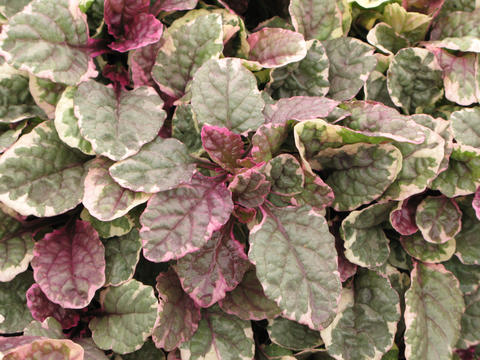Bugleweed
Bugleweed is an easy-care groundcover with pretty leaves and flowers as well as analgesic properties. Here are our tips for planting and care.
Factsheet
- Growth type
-
- Perennial plant
- Growth height (from)
- from 15 cm to 20 cm
- Growth width (from)
- from 20 cm to 25 cm
- Growth characteristics
-
- flat growing
- carpet forming
- foothills
- Flower color
-
- purple
- blue
- Flowering time (month)
-
- April to June
- Flower shape
-
- whorls
- Leaf color
-
- green
- red
- page format
-
- spatula-shaped
- Sheet properties
-
- wintergreen
- Rosette
- Fruit shape
-
- nut fruit
- Fruit characteristics
-
- Self-seeding
- Light
-
- sunny to semi-shade
- Soil type
-
- sandy to loamy
- Soil Moisture
-
- fresh to humid
- ph value
-
- neutral to weakly acidic
- Lime compatibility
-
- lime-tolerant
- Nutrient requirements
-
- nutrient-rich
- Humus
-
- rich in humus
- Decorative or utility value
-
- Flower Decoration
- Leaf ornaments
- medicinal plant
- native wild plant
- Toxicity
-
- non-toxic
- Winter Hardness
-
- hardy
- Climate zones according to USDA
-
- 6
- areas of life
-
- GR2
- GR3
- FR2
- FR3
- Use
-
- Floor mounting
- ground cover
- Embankments
- Group planting
- Pond planting
- Underplanting
- Surface greening
- Rebates
- Garden style
-
- Pharmacy Garden
- Flower garden
- natural garden
- Park area
- Forest Garden
- Bee Friendly
- bee friendly plant
Bugleweed (Ajuga reptans) is a native wild shrub from the labiate (Lamiaceae) family. It spreads across regions from Europe, Tunisia and Algeria to the Caucuses and northern Iran. Over time, it has also become naturalized in North America. It is particularly common in swampy forests, on meadows and mountainsides.
The carpet-forming shrub is very good and spreads quickly through offshoots. Ajuga reptans grows up to 7.87 inches tall and is generally as wide as it is tall.
The leaves of Bugleweed are metallic and shiny, with colors ranging from green to brown or red, some varieties have even started to demonstrate different colors all at once. The wintergreen leaves grow up to 3.15 inches long. They are spatulate and usually slightly crenelated, the basal leaves grow in a rosette.
Bugleweed has a conspicuous, up to 7.87 inch long inflorescence. The flowers appear on top of each other in several whorled levels from April to June. They are generally violet-blue in color, although there are also pink or white varieties. The lower labellum of the Bugleweed’s flower is always bigger than the upper one.

Ajuga reptans forms small nutlets as fruit.
Bugleweed loves a semi-shady location between or in front of woods or walls. It also tolerates full sun on moist pond and stream banks. As a rule of thumb: The damper the soil, the more sun it will tolerate. The light ratios have an effect on the color of the leaves in some species.
Bugleweed thrives best on soils which are permanently damp. The substrate should be sandy-loamy, nutrient and humus rich.
As Bugleweed spreads very quickly, ten plants per square yard are generally sufficient. The saplings should be planted at a distance of 12 to 14 inches. from one another.
Ajuga reptans is extremely easy-care groundcover which can even be mown once a year with a lawnmower. This is best done after flowering and ensures an even denser plant carpet. Special care measures are not generally necessary. However, a thin layer of semi-ripe compost applied once a year has a positive effect on the growth of this shrub. This rapid-growing plant which threatens to overrun its neighbors can simply be staked out at the edges.
Ajuga reptans can be propagated by dividing the mother plant in the spring or fall.
Bugleweed is perfect for under-planting bushes, trees and large shrubs, for example, meadow-rue (Thalictrum), globeflower (Trollius) and also Astilbe. Varieties with colored or variegated leaves are generally used in the garden. These can also be superbly combined with one another or with the species. Bulbous plants such as Summer Snowflakes (Leucojum) or Snowdrops (Galanthus) can also provide colorful accents to the Bugleweed’s decorative foliage. This groundcover is also perfect for providing soil conservation on shady slopes.
Bugleweed is also known as a healing plant. As it has slightly analgesic properties, it can be used on wounds. In the past, it was also used as a gentle laxative and is one of the healing plants purported to have a liver cleansing effect.

The variety ‘Alba’ flowers in white and has lush, green foliage. Some types have orange colored stems and slightly spotted flowers. Ajuga reptans ‘Atropurpurea’ is one of the most frequently used varieties and has extremely dark, single-colored violet-brown leaves with a bronze shimmer and a bright blue flower. Ajuga reptans ‘Burgundy Glow’ has silver-green and bronze colored, variegated leaves which get darker in the fall. ‘Multicolor’ is a variety with conspicuous, colorful leaves which come mixed in red and green, as well as white, pink and yellow shades.
Bugleweed can be easily propagated in spring through division or rooted layering. In good location conditions it will readily self-seed, the species and varieties can also be drawn from seeds. It is important here to cover with a thick layer of substrate, as it germinates in darkness.
In unfavorable weather, Ajuga reptans may occasionally develop mildew, but this usually disappears again quickly.

